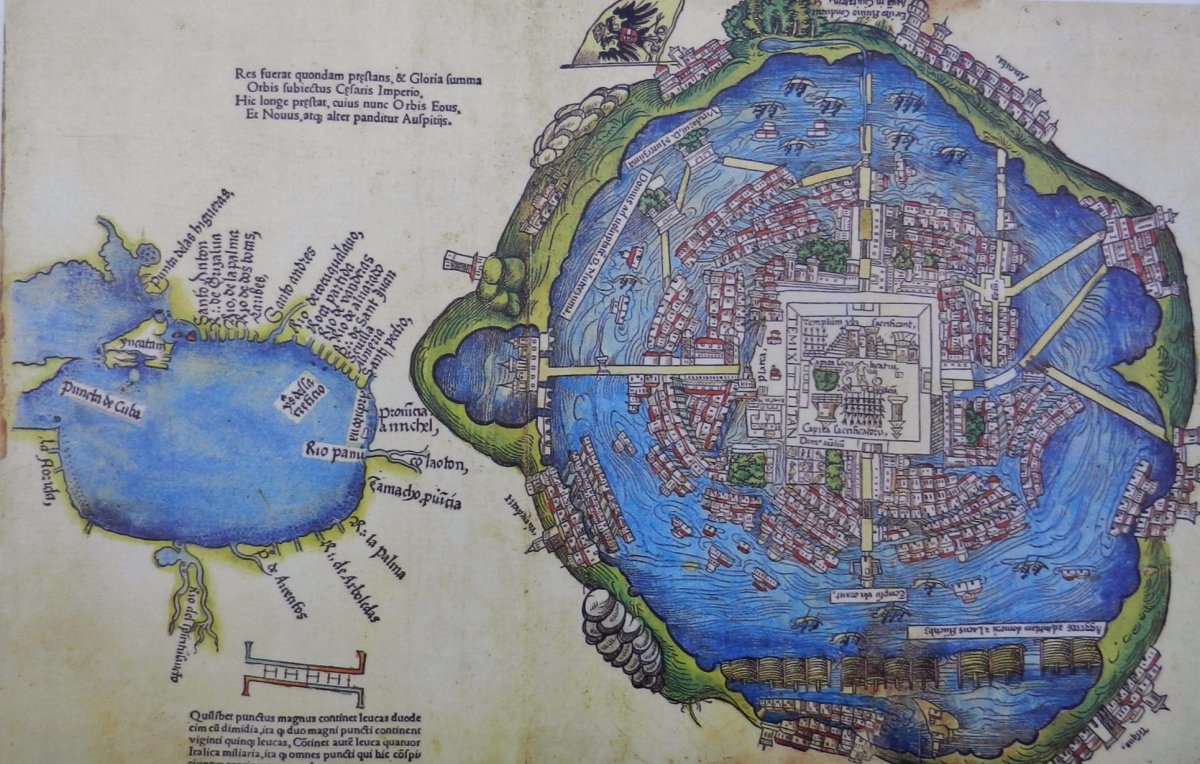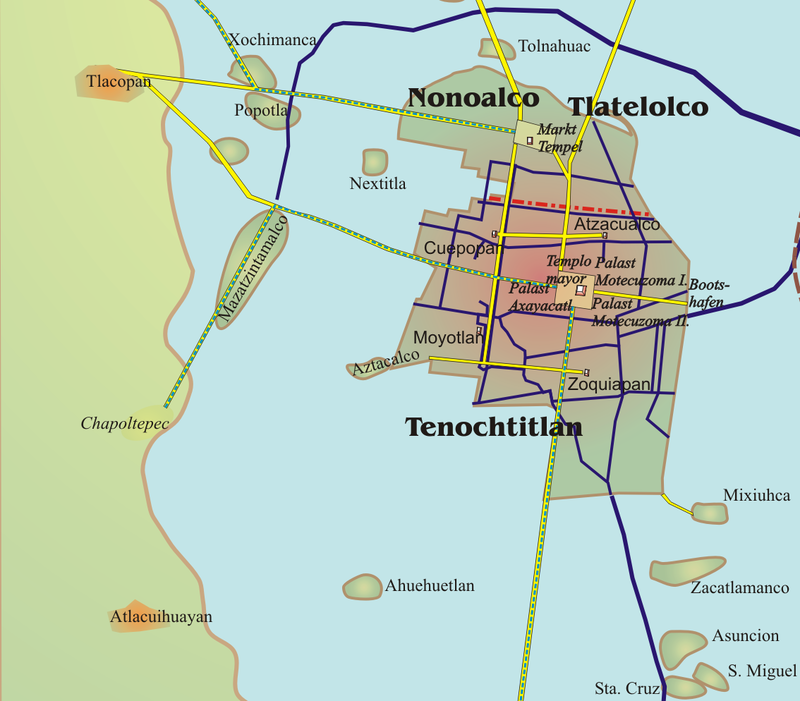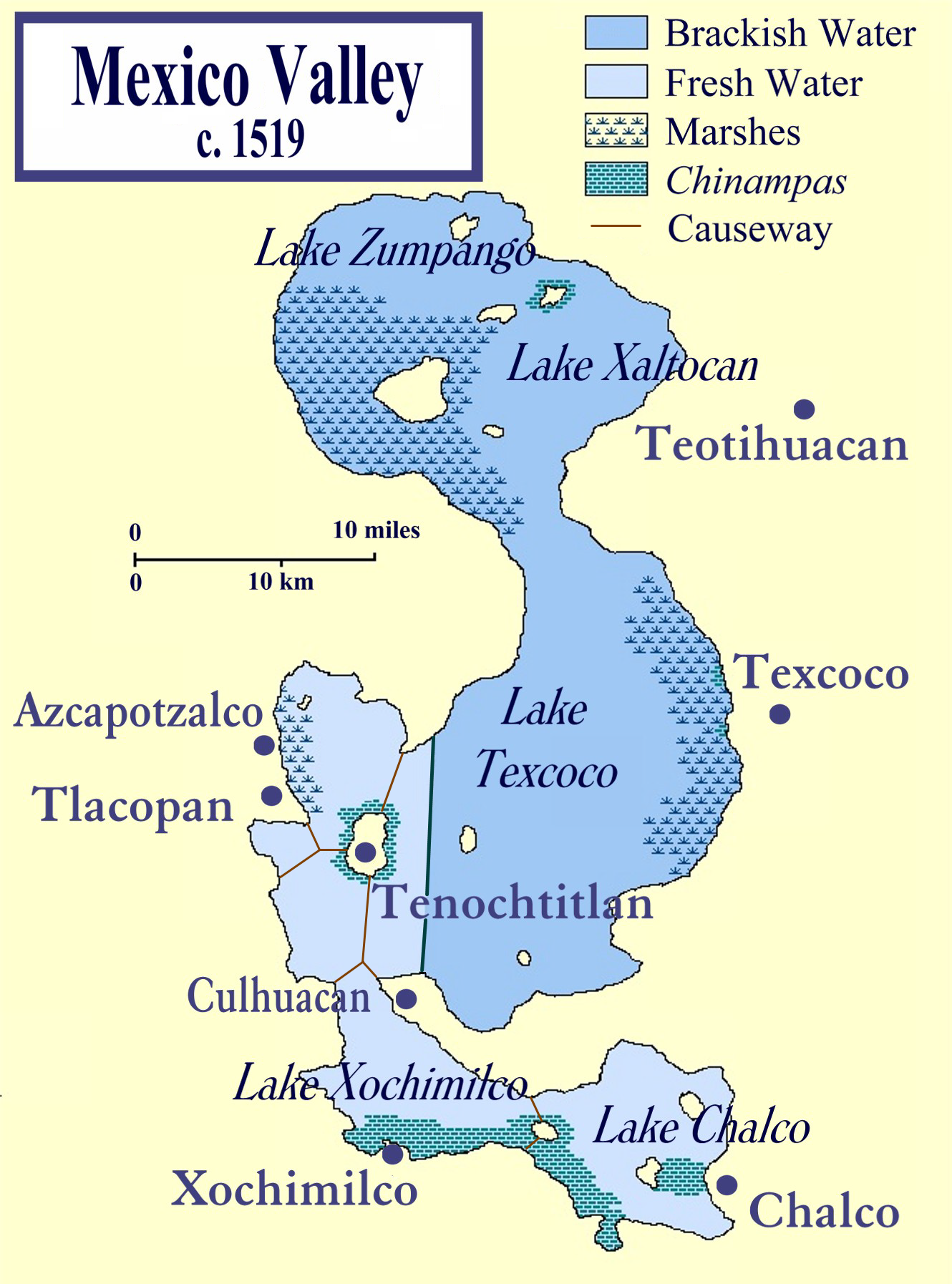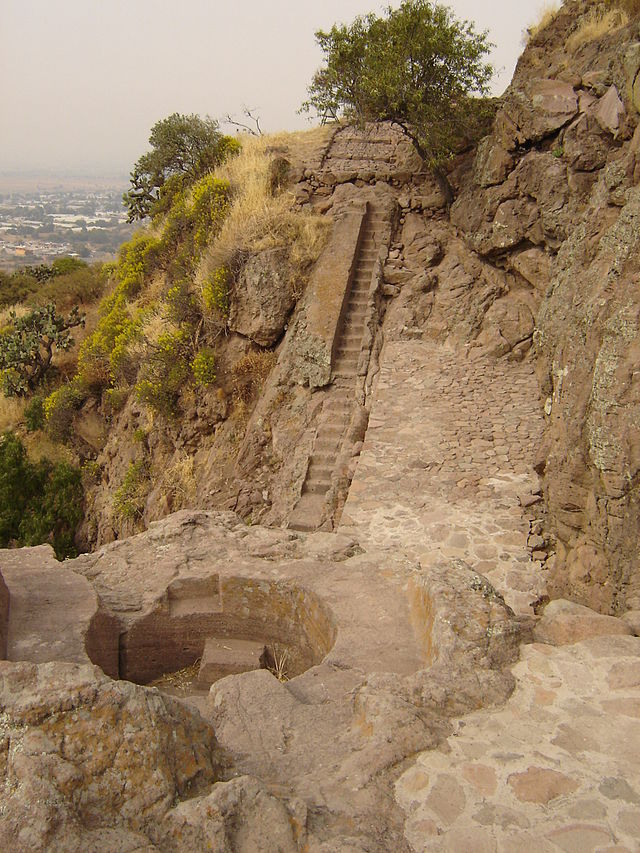The Aztecs, later known as Mexicas, came from Northern Mexico. The nomadic tribe settled on an island in Lake Texcoco in the 13th century, and founded their capital city, Tenochtitlan. They shortly became the dominant force in the region, and with their intricate commercial, religious, political, and social organization, the Aztecs brought many of the city-states in the region under their control.
They had a sophisticated agricultural system of irrigation and land cultivation methods to grow maize, squash, beans, tomatoes, potatoes, and avocados. Together with their military tradition, they built a successful state, and through various military campaigns, a powerful empire.
One of their leaders, Itzcoatl formed a three-way alliance with Texcoco and Tlacopan. Through commerce and conquests, the Aztec ruled more than 500 small states and around five to six million people. At the height of the empire, over 140,000 inhabitants lived in their capital city.
Learn more about the top city-states of the Aztecs here.
Tenochtitlan

Tenochtitlan was an altepetl or city-state, which the Aztecs built on an island in Lake Texcoco around the first quarter of the 14th century. By the 15th century, Tenochtitlan was the Aztec Empire’s capital and center of communication and power. During the empire’s peak, Tenochtitlan was pre-Columbian America’s largest city, covering about 8 to 13.5 square kilometers or 3.1 to 5.2 square miles. It was connected to the mainland by causeways and removable bridges that led to the west, north, and south. In addition, several canals traversed the city so that people could reach any section of the city by canoe or on foot.
There were 45 public buildings in the city-state, including the Templo Mayor. In addition, various temples, a walled square, several markets, and the enormous 100-room palace of Moctezuma II surrounded the temple. The total population was estimated to be between 200,000 to 400,000 inhabitants.
Tlatelolco

Tlatelolco was Tenochtitlan’s neighboring altepetl, built by Aztec dissidents in the southern part of the island. The city-state was founded in 1338, thirteen years after the foundation of Tenochtitlan. They later became sister cities, with Tenochtitlan dependent on Tlatelolco’s market, which became the center of commerce in the region.
Tlatelolco had its main temple, the Main Pyramid of Tlatelolco, and the largest market. The people (Tlatelolcas) were well-educated, and the city housed various specialist artisans comparable to the European guild during the Middle Ages. For example, some groups specialized in feather works. In addition, some artisan groups specialized in brewing pulque, while others were goldsmiths.
Bernal Diaz del Castillo, a conquistador, observed that many people patronized the market, which sold a wide variety of goods. Likewise, they were amazed at the control and order maintained in the market, which they had never seen before.
Tlacopan

Lake Texcoco’s western shore was the location of the Aztec city-state Tlacopan, also known as Tacuba—a name still used by a Mexico City neighborhood. It used to be a subordinate altepetl of Tepanec, a long-time adversary of Tenochtitlan. After Tlacopan successfully conquered its neighbor, Azcapotzalco, it joined the city-states Tenochtitlan and Texcoco to form the Aztec Triple Alliance. However, Tlacopan became a minority in the alliance and received only five percent of the tributes received by the coalition from their major campaigns against other city-states.
Azcapotzalco

Azcapotzalco, the capital of the Tepanec Empire, was located on Lake Texcoco’s western shore. It was founded by Chichimecs centuries before the Aztecs came to the valley. The group comprised several tribal groups, estimated at around eight different tribes that spoke Nahuatl in different versions. They were primarily hunter-gatherers. Thus, they displayed a more vicious nature. According to a record, they settled in the area around 1012 AD, located about 7,350 feet (2,240 meters) above sea level. Its name translates to anthill because it had a large population.
They did not have a strong hold on their city; thus, the Tepanecs quickly overcame them. Later, the Aztecs conquered the city-state.
Azcapotzalco was famous for its slave market. However, there were many skilled artisans in the area, including those who worked on precious metals.
Culhuacan

Another city-state in the Valley of Mexico was Culhuacan, where the Toltecs under Mixcoatl founded the city. It became Toltec’s first city and the first city to grant its rulers the title of tlatoani (speaker). In addition, historians believed that Culhuacan was the first town with chinampas (floating gardens) built on the shore of Xochimilco Lake.
Based on written records, in 1299, one of its rulers, Coxcoxtli, helped a group comprising Azcapotzalco’s Tepanecs, the Xochimilco, and other cities drive away their main rival, the Aztecs that settled at Chapultepec. However, Coxcoxtli, the Culhuacan’s king, allowed the Aztecs to settle in Tizapan, a barren land close to Chapultepec. They became subjects of the Culhuacan and eventually assimilated into the Culhuacan culture, while the Aztec soldiers became their mercenaries.
Tetzcoco

The city-state of Tetzcoco was a member of the Aztec Triple Alliance. It was the primary city-state in the central Mexican plateau, located in the eastern part of Lake Texcoco. Tetzcoco was second to Tenochtitlan in prestige and size when the Spanish arrived. By that time, Tetzcoco’s size was about 450 hectares, where more than 24,000 Tetzcocah (Tetzcoco natives) resided.
Historians believed that the Chichimecs also founded Tetzcoco around 1337. It became the capital city of Acolhua after the Tepanec, and Acolhua expelled the Chichimecs from the area.
Tetzcoco was a center of learning, with a library that contained books from earlier civilizations. According to a study, the royal residence—built near a hill and had stairways, gardens, baths, and aqueducts—was designed to align with astronomical events rather than cardinal directions. A series of canals and marble stairs serving as waterfalls brought spring water from beyond the mountain down to the city.
Chalco

Chālco was a pre-Columbian complex and part of the Aztec Empire. It was a city-state with four sub-cities. Each sub-city is further divided into barrios, although each has a reigning tlatoani (speaker). The Aztecs and the Chālcah, or the inhabitants of Chalco, fought many flower wars. Flower wars are ritual wars fought with a set of conventions, which was a way to get plenty of prisoners for their human sacrifices.
A serious war between the Aztecs and the Chālcah occurred in 1446 because the latter refused to contribute building materials to construct Huitzilopochtli’s temple. As a result, the Aztecs entirely conquered Chālco in 1465. As a result, the city-state paid food tribute to Tenochtitlan generously because of its proximity to the capital city and its fertile soil.
Xochimilco

The Xochimilca people placed high importance on the city of Xochimilco. Founded around 900 AD, it predates the arrival of the Aztecs in the Valley of Mexico. However, the Aztecs of Tenochtitlan eventually conquered the city in 1430. After being beaten by Tenochtitlan, Itzcoatl built a causeway that connected the two cities.
The city’s name means flower field in Nahuatl as the area had various crops and flowers growing on chinampas or floating gardens. They were one of the seven Nahua tribes that settled in the valley, and they worshipped 16 deities, including Amimitl, the god of chinampas.
Since the beginning, they had been farmers. Their leader, Acatonallo, invented the chinampa system of agriculture. Corn, squash, chili peppers, beans, and other crops were their primary produce. In addition, they had a woman ruler credited for adding several unique dishes to their city, such as tlapiques, esquites, chileatolli, and necuatolli.
Xoconochco (Soconusco)

Soconusco or Xoconochco was a state geographically isolated from the economic and political center of the Valley of Mexico. It was located on the border between Central America and Mexico. But because of the trade route, it identified with central Mexico. It produced various agricultural products, including achiote and cacao. It was also known for its coffee production.
Aztec tlatoani Ahuitzotl led a successful conquest of Soconusco in 1486. As a result, the Aztec emperor required the city to send tribute, including cacao, jaguar skins, bird feathers, and cotton clothing.
Coixtlahuaca

The city-state of Coixtlahuaca was a multi-ethnic polity where Mixtecs and Chochos resided. Before the arrival of the Spanish conquistadors, the population of Coixtlahuaca was between 15,000 and 25,000. The city’s name translates to plain of snakes. In the 15th century, Moctezuma I led the successful campaign to conquer Coixtlahuaca. Archeological excavations revealed nests of rattlesnakes in the area.
Coixtlahuaca was founded in 37 AD by the Chocholtecs. According to records, the city’s last emperor, Atonaltzin, fought against the Aztecs twice, and lost in both instances. Their final defeat was in the hands of Moctezuma II, wherein much of the area was conquered.
The city was famous for its pictorial manuscript cloths or lienzos created by indigenous painter-scribes. The Lienzo of San Mateo Tlapiltepec is at a museum in Ontario, Canada. The city wants it back, but the recuperation fee is US $20,000,000, which the community cannot afford.